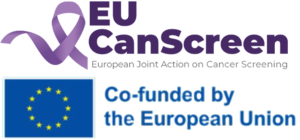Work Package 10:
Modelling and health technology assessment to optimise cancer screening programs across Europe
WP 10
Modelling

EMC, Netherlands
Work Package Summary
The overall objective is to optimize and prioritize existing and new screening programmes.
Specific objectives are as follows:
1) To estimate benefits, harms, cost-effectiveness and resource requirements of existing programmes and the impact of addressing barriers and facilitators;
2) To assess the impact of new technologies and approaches of screening (new screening tests, IA, additional cancer sites, and risk-based screening);
3) To develop tools to help countries prioritize screening interventions.
EMC, Netherlands
Tasks
| Task Nr | Task Name | Description | Participants |
| T10.1 | Adapting cervical cancer screening programmes to HPV vaccinated birth cohorts | Data on HPV vaccination coverage, screening attendance, cervical cancer related burden and healthcare costs, and sexual activity when available, will be systematically collected in reference countries. The data will be transformed for model input. The cervical cancer screening model will be adjusted to these reference countries and validated using selected reference countries. A set of screening scenarios will be modelled to identify feasible and optimal scenarios for each reference country. This task will be led by THL, Finland. | LU THL, OIL, SCI UMIT TIROL, BIOSISTEMAK, CSF, RSU, OUS |
| T10.2 | Estimation of benefits, harms, and resource requirements of current screening programs and the impact of addressing barriers and facilitators or enablers | The EU-TOPIA web tool will be extended with data collected for the exemplary countries in WP4: Slovakia, Romania, Hungary, Estonia, Ukraine and Slovenia. Parts of the tool will be cross-validated against UMIT TIROL models focusing on CRC. Finally, the tool will be applied for simulation of current situations and barriers and facilitators for all participating countries identified in WP6. Non-exemplary countries will be supported in collecting data for use in the model, application of the web tool and interpretation of model results. This task will be led by EMC, Netherlands. | LU IOL, NKIP, TAI, PHC, UZIS, ICO EMC, UMIT TIROL, MSCI BIOSISTEMAK, IOCN, NIJZ, CSF, HSE, DYPEDE, FISABIO |
| T10.3 | Estimation of benefits, harms, and resource requirements to implement new screening approaches | Regional (North, East, South and West) MISCAN models for prostate, gastric and lung cancer will be developed, based on data of one exemplary country per region. New elements in these data collections are smoking history patterns, the amount of opportunistic PSA testing and the prevalence of H. pylori. The prostate cancer model will be cross validated by the UMIT TIROL model. Next, the EU-TOPIA web-based tool with options will be extended to simulate these new cancers. We will assist other countries in collecting data required in the web tool, application of the web tool and interpretation of the model results. This task will be led by EMC, Netherlands. | LU IO L EMC, NIJZ, UMIT TIROL, BIOSISTEMAK |
| T10.4 | Comparison of benefits, harms, and resource requirements across screening programs to help countries prioritise screening interventions | Estimates of effectiveness and costs of screening interventions from tasks 10.2 and 10.3 will be integrated in a predictive model to derive comparative estimates of the impact of different screening (and possibly primary prevention) interventions, using DALYs as a common metric to account for the health impact of the interventions. Using the information about the economic value of a DALY and about the cost of the considered interventions, the model will allow to estimate the timing of the ROI. Results of these analyses will be used to inform the prioritisation process adopting the methodology developed in task 4.4, to support policy decision about which intervention to prioritise by country/region. We will test the model in exemplary countries from task 4.4 and in non-exemplary countries, to share experiences and discuss similarities and differences. This task will be led by CPO, Italy, co-led by EMC, Netherlands. | LU IOL, PHC, NKIP, UZIS, CPO, EMC, CSF, BIPS, UMIT TIROL, HSE, DYPEDE, TAI, IOCN |
| T10.5 | Assessment of new technologies and approaches in cancer screening | We will explore the potential for extending the application of the methodology developed in task 4.4.4 for assessing AI technologies and novel approaches in cancer screening tests across Europe. The aim is to apply the MAS-AI methodology adopted to the European context in 2-3 clinical use cases from participating countries. The inclusion criteria for the use cases is that they are built on or utilize state-of-the-art AI technology as a component in the national cancer screening programs in participating countries. By applying the model on specific European use cases, the aim is to assess the feasibility, acceptability and comprehensibility of the model in different countries across Europe and to validate the transferability of the model in the context of European cancer screening. This task will be led by RSYD, Denmark, co-led by CPO, Italy and EMC, the Netherlands | RSYD, PHC, INCa CPO, EMC, DYPEDE, BIOSISTEMAK, BIPS, IACS, UMIT TIROL, |
| T10.6 | Estimation of benefits, harms, and resource requirements of riskbased screening approaches | MISCAN and EU-TOPIA models will be used to estimate additional harms, benefits and costs of risk-based screening approaches compared to existing uniform screening approaches by region of Europe. This task will be led by EMC, Netherlands, co-led by UMIT, Austria. | LU, IOL, PHC EMC, DYPEDE UMIT TIROL, BIOSISTEMAK, CSF, FISABIO |
| T10.7 | Medico-economical modelling and cost effectiveness of multicancer early detection (MCED) tests | Execution of this task entails activities including workshop and consensus of multidisciplinary experts methodology to assess the potential health impact of different MCED approaches; review and analysis of all available and upcoming evidence using a multimodel approach (literature review, workshops, interviews of experts and companies, final workshop using a consensus methodology) for the purpose of assessing the scientific and medical value of MCEDs including health technology readiness; review and analysis of published models and analyses assessing the available evidence, together with an analysis of gap of knowledge regarding medico-economical modelling and cost effectiveness analyses of MCEDs; multidisciplinary review and analysis of existing and required evidence regarding the implementation of MCEDs including equity issues, health organization impact of MCEDS (need for micro invasive surgery platforms, specific HCP workforces or codevelopment of cancer interception/prevention approaches), and workshop discussion and consensus to describe the required framework and policies for the development of MCEDs This task will be led by UNICANCER, France, co-led by EMC, Netherlands. | Unicancer, EMC, IOCN, UMIT TIROL, IDIVAL, OUS |
| Task Nr | Task Name | Description | Participants | Role | In-kind Contributions/Subcontracting |
| T10.1 | Adapting cervical cancer screening programmes to HPV vaccinated birth cohorts | Data on HPV vaccination coverage, screening attendance, cervical cancer related burden and healthcare costs, and sexual activity when available, will be systematically collected in reference countries. The data will be transformed for model input. The cervical cancer screening model will be adjusted to these reference countries and validated using selected reference countries. A set of screening scenarios will be modelled to identify feasible and optimal scenarios for each reference country. This task will be led by THL, Finland. | LU THL, OIL, SCI UMIT TIROL, BIOSISTEMAK, CSF, RSU, OUS | COO BEN | No |
| T10.2 | Estimation of benefits, harms, and resource requirements of current screening programs and the impact of addressing barriers and facilitators or enablers | The EU-TOPIA web tool will be extended with data collected for the exemplary countries in WP4: Slovakia, Romania, Hungary, Estonia, Ukraine and Slovenia. Parts of the tool will be cross-validated against UMIT TIROL models focusing on CRC. Finally, the tool will be applied for simulation of current situations and barriers and facilitators for all participating countries identified in WP6. Non-exemplary countries will be supported in collecting data for use in the model, application of the web tool and interpretation of model results. This task will be led by EMC, Netherlands. | LU IOL, NKIP, TAI, PHC, UZIS, ICO EMC, UMIT TIROL, MSCI BIOSISTEMAK, IOCN, NIJZ, CSF, HSE, DYPEDE, FISABIO | COO BEN | No |
| T10.3 | Estimation of benefits, harms, and resource requirements to implement new screening approaches | Regional (North, East, South and West) MISCAN models for prostate, gastric and lung cancer will be developed, based on data of one exemplary country per region. New elements in these data collections are smoking history patterns, the amount of opportunistic PSA testing and the prevalence of H. pylori. The prostate cancer model will be cross validated by the UMIT TIROL model. Next, the EU-TOPIA web-based tool with options will be extended to simulate these new cancers. We will assist other countries in collecting data required in the web tool, application of the web tool and interpretation of the model results. This task will be led by EMC, Netherlands. | LU IO L EMC, NIJZ, UMIT TIROL, BIOSISTEMAK | COO BEN | No |
| T10.4 | Comparison of benefits, harms, and resource requirements across screening programs to help countries prioritise screening interventions | Estimates of effectiveness and costs of screening interventions from tasks 10.2 and 10.3 will be integrated in a predictive model to derive comparative estimates of the impact of different screening (and possibly primary prevention) interventions, using DALYs as a common metric to account for the health impact of the interventions. Using the information about the economic value of a DALY and about the cost of the considered interventions, the model will allow to estimate the timing of the ROI. Results of these analyses will be used to inform the prioritisation process adopting the methodology developed in task 4.4, to support policy decision about which intervention to prioritise by country/region. We will test the model in exemplary countries from task 4.4 and in non-exemplary countries, to share experiences and discuss similarities and differences. This task will be led by CPO, Italy, co-led by EMC, Netherlands. | LU IOL, PHC, NKIP, UZIS, CPO, EMC, CSF, BIPS, UMIT TIROL, HSE, DYPEDE, TAI, IOCN | COO BEN AE | No |
| T10.5 | Assessment of new technologies and approaches in cancer screening | We will explore the potential for extending the application of the methodology developed in task 4.4.4 for assessing AI technologies and novel approaches in cancer screening tests across Europe. The aim is to apply the MAS-AI methodology adopted to the European context in 2-3 clinical use cases from participating countries. The inclusion criteria for the use cases is that they are built on or utilize state-of-the-art AI technology as a component in the national cancer screening programs in participating countries. By applying the model on specific European use cases, the aim is to assess the feasibility, acceptability and comprehensibility of the model in different countries across Europe and to validate the transferability of the model in the context of European cancer screening. This task will be led by RSYD, Denmark, co-led by CPO, Italy and EMC, the Netherlands | RSYD, PHC, INCa CPO, EMC, DYPEDE, BIOSISTEMAK, BIPS, IACS, UMIT TIROL, | BEN AE | No |
| T10.6 | Estimation of benefits, harms, and resource requirements of riskbased screening approaches | MISCAN and EU-TOPIA models will be used to estimate additional harms, benefits and | LU, IOL, PHC EMC, DYPEDE UMIT TIROL, BIOSISTEMAK, CSF, FISABIO | COO BEN | No |
| T10.7 | Medico-economical modelling and cost effectiveness of multicancer early detection (MCED) tests | Execution of this task entails activities including workshop and consensus of multidisciplinary experts methodology to assess the potential health impact of different MCED approaches; review and analysis of all available and upcoming evidence using a multimodel approach (literature review, workshops, interviews of experts and companies, final workshop using a consensus methodology) for the purpose of assessing the scientific and medical value of MCEDs including health technology readiness; review and analysis of published models and analyses assessing the available evidence, together with an analysis of gap of knowledge regarding medico-economical modelling and cost effectiveness analyses of MCEDs; multidisciplinary review and analysis of existing and required evidence regarding the implementation of MCEDs including equity issues, health organization impact of MCEDS (need for micro invasive surgery platforms, specific HCP workforces or codevelopment of cancer interception/prevention approaches), and workshop discussion and consensus to describe the required framework and policies for the development of MCEDs This task will be led by UNICANCER, France, co-led by EMC, Netherlands. | Unicancer, EMC, IOCN, UMIT TIROL, IDIVAL, OUS | AE | No |
Subscribe to our newsletter to get news and updates.
Subscribe to our newsletter to get news and updates.

The general objective of EUCanScreen is to assure sustainable implementation of high-quality screening for breast, cervical and colorectal cancers, as well as implementation of the recently recommended screening programs – for lung, prostate and gastric cancers. EUCanScreen will facilitate the reduction of cancer burden and achieving equity across the EU.
This project has received funding from the European Union’s EU4HEALTH Programme under the Grant Agreement no 101162959











